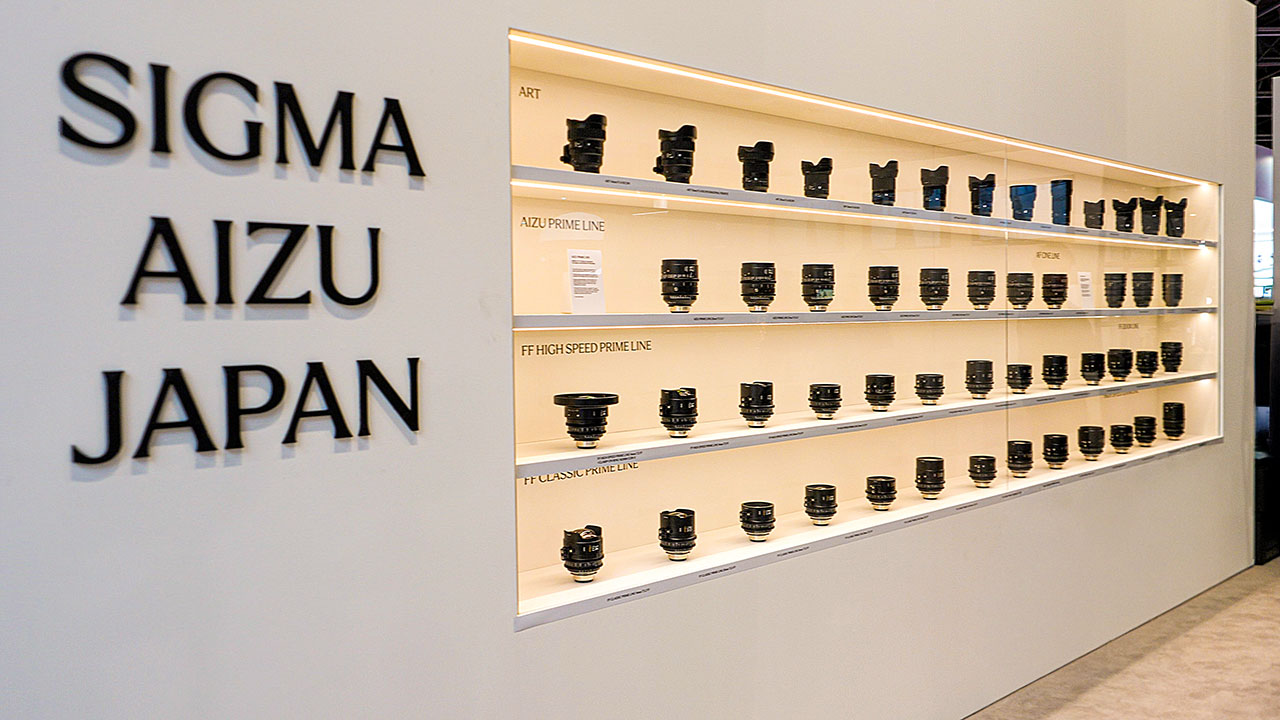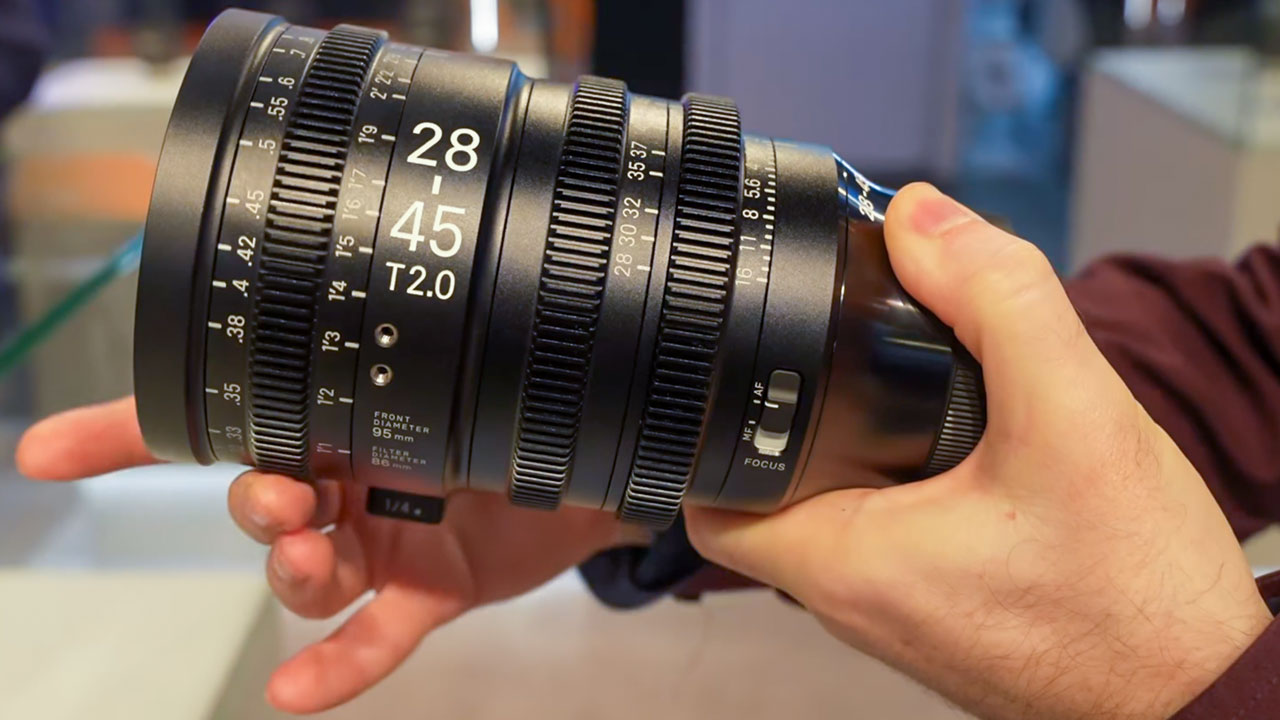During IBC 2025, we had a chance to interview Mr. Kazuto Yamaki, the CEO of Sigma, and ask him about some of the many new lenses the company announced this year, including the one-of-a-kind 135mm f/1.4, the 20-200mm, and more, and about more general topics, including AI and how it might affect the industry in his view.
Sigma’s unraveled lens line for 2025
Looking at the lenses announced/released by Sigma in 2025, we get an unprecedented line of AF lenses, more than any other manufacturer in 2025 (or any recent year, for that matter). Coming up with so many new lenses is hard enough, but coming up with so many completely new designs is truly unheard of, including lenses that did not exist at all in the market, such as the 135mm f/1.4 and the 20-200mm f/3.5-f/6.3.
Below is a brief list of the new (and upcoming lenses released and announced by Sigma this year.
Sigma’s lenses on display at IBC 2025
Sigma 35mm F1.2 DG II | Art
Sigma’s second-generation 35mm F1.2 DG II | Art is a full-frame autofocus prime designed for Sony E and L mounts. The lens features a revised optical formula with improved sharpness and reduced aberrations, along with faster and quieter autofocus using Sigma’s HLA (High-response Linear Actuator) motor. It includes weather sealing, an aperture ring with a de-click option, and supports customizable AFL buttons. The lens maintains a maximum aperture of f/1.2, a rounded 11-blade diaphragm, and an updated build that is slightly lighter and shorter than the original 2019 version.
Pricing for the Sigma 35mm F1.2 DG II is set at $1550.
Sigma 135mm F1.4 DG | Art
The 135mm F1.4 DG | Art is a new full-frame autofocus telephoto prime lens. It is notable for being the first autofocus 135mm lens with an f/1.4 aperture. It incorporates 19 elements in 13 groups, including FLD and SLD elements to control chromatic aberration and improve edge-to-edge clarity. The autofocus system uses an HLA motor for precise, quiet operation, and the lens is sealed against dust and moisture. It has an 11-blade diaphragm and supports both Sony E and L mounts.
Pricing for the Sigma 135mm F1.4 DG is set at $1900.
Sigma 200mm F2 DG OS | Sports
The 200mm F2 DG OS | Sports is a full-frame telephoto prime aimed at action, wildlife, and low-light applications. It uses a 19-element, 14-group optical design with FLD and SLD glass to minimize color fringing. The lens features Sigma’s Optical Stabilization (OS2) system rated up to 6.5 stops, paired with a high-speed HLA autofocus motor. It offers a maximum aperture of f/2, a minimum focus distance of 1.7 m, and a maximum magnification of 0.13×. The lens is weather-sealed, weighs around 1.8 kg, and uses a 105 mm front filter thread. Mounts include Sony E and L.
The Sigma 200mm F2 DG OS sells for $3300.
Sigma 20-200mm F3.5-6.3 DG | Contemporary
This full-frame all-in-one zoom covers a wide to telephoto range, designed primarily for travel and general-purpose photography. The optical construction includes multiple aspherical and low-dispersion elements to maintain image quality across the zoom range. Autofocus is driven by an HLA motor for improved precision and responsiveness. The lens has a close focusing capability of approximately 40 cm at the wide end and features weather resistance around the mount. It is compatible with Sony E and L mounts and weighs approximately 700 g.
The Sigma 20-200mm F3.5-6.3 DG sells for $1000.
4 New Sigma lenses from 2025 (135mm, 12mm, 35mm f/1.2, and the 20-200mm)
 Sigma 300-600mm F4 DG OS | Sports
Sigma 300-600mm F4 DG OS | Sports
The Sigma 300-600mm F4 DG OS | Sports (first teased in late 2024) is a full-frame, ultra-telephoto zoom lens designed for wildlife, sports, and action photography. It offers a constant f/4 maximum aperture throughout the zoom range, paired with an optical stabilization system (OS2) rated at approximately 5.5 stops at 600mm using CIPA guidelines. The lens has an optical construction of 28 elements in 21 groups, including six FLD and one SLD glass elements, along with high-refractive-index glass, to reduce chromatic aberration and maintain sharpness across the frame. It features a 13-blade rounded diaphragm, a minimum aperture of f/22, and a close-focusing distance of roughly 2.8 m at the wide end and about 4.5 m at the telephoto end. At around 470mm it delivers a maximum magnification of around 1:6. The build includes a magnesium alloy body, thermal-insulation paint to limit heat-related distortion, robust weather sealing, and a “function ring” that supports both Focus Preset and Power Focus modes. It also accepts rear drop-in filters (40.5 mm size) and is supplied with accessories, including a lens hood, tripod socket, and protective caps. The lens weighs about 3,970-3,985 grams, and its size is approximately 167 mm diameter × ~468-470 mm length, depending on mount.
The Sigma 300-600mm F4 DG OS | Sports sells for $6600.
Sigma 28-45mm T2 FF AF Cine Zoom (Upcoming)
The 28-45mm T2 FF AF is Sigma’s first autofocus cine zoom lens, part of the new AF Cine line introduced in 2025. Designed for full-frame cinema cameras with Sony E and L mounts, it features a constant T2 aperture and electronic communication for metadata and autofocus. The optical design minimizes focus breathing and maintains consistent image quality across the zoom range. The housing includes standard cine-style gearing and markings, while retaining the internal focusing and zoom mechanisms typical of cinema lenses.
The upcoming Sigma 28-45mm T2 FF AF Cine lens
 Sigma 28–105mm T3 FF AF Cine ZOOM (Upcoming)
Sigma 28–105mm T3 FF AF Cine ZOOM (Upcoming)
The Sigma 28–105mm T3 FF AF Cine is part of Sigma’s newly introduced AF Cine Line, representing the company’s first autofocus-enabled full-frame cinema zooms. Designed for Sony E and Leica L mounts, the lens maintains a constant T3 aperture throughout the zoom range and is optimized for both professional video production and hybrid workflows. It features internal focusing and zooming to preserve balance on gimbals, with standard 0.8 M pitch gears for focus, iris, and zoom control. The optical design is derived from Sigma’s Art series, ensuring consistent sharpness and minimal chromatic aberration across the frame. Autofocus operation is powered by Sigma’s High-response Linear Actuator (HLA) system, and manual override remains available for controlled focus pulls. The lens has a 95 mm front diameter, a close focus distance of approximately 0.4 m, and a clickless aperture ring. It is scheduled for release in 2026, following its official development announcement in mid-2025.
Sigma 17-40mm F1.8 DC | Art (APS-C)
The Sigma 17-40mm F1.8 DC | Art is a constant-aperture zoom lens for APS-C mirrorless cameras, offering a field of view roughly equivalent to 25-60 mm on full-frame systems. It maintains an f/1.8 aperture across the zoom range and uses an HLA (High-response Linear Actuator) autofocus motor for rapid and near-silent operation. The optical construction includes 17 elements in 11 groups, featuring four SLD and four aspherical elements to suppress aberrations and maintain edge-to-edge sharpness. The lens supports a minimum focusing distance of 28 cm and achieves a maximum magnification of 1:4.8. It is internally zooming, minimizing balance shifts, and has a 67 mm front filter thread. The design includes dust- and splash-resistant sealing, an 11-blade rounded diaphragm, and is available in Sony E, L-Mount, Fujifilm X, and Canon RF versions.
The Sigma 17-40mm F1.8 DC sells for $920.
Sigma 12mm F1.4 DC | Contemporary (APS-C)
The Sigma 12mm F1.4 DC | Contemporary is an ultra-wide-angle prime lens for APS-C mirrorless cameras, scheduled for release on September 4, 2025. It achieves a field of view of about 99.6° (for Sony E, Fujifilm X), slightly less for Canon RF, with a maximum aperture of f/1.4 and a minimum aperture of f/16. Its optical formula comprises 14 elements in 12 groups, including two SLD and three aspherical elements, which assist in controlling aberrations and maintaining sharpness even wide open. It uses a 9-blade rounded diaphragm, has a close focusing distance of 17.2 cm, and offers a maximum magnification of approximately 1:8.4. The lens is relatively compact and lightweight for its class, with φ62 mm filter thread size, φ68.0 mm × 69.4 mm in diameter × length (Sony E-mount), and weighs roughly 225 g. Mount options include Sony E, Fujifilm X, and Canon RF.
The Sigma 12mm F1.4 DC sells for $630.
Cine Mirrorless line
We asked Mr. Kazuto Yamaki if Sigma has plans to introduce a compact Cine line for mirrorless lenses and if the upcoming 28-45 and 28-105 lenses are part of this line. The answer to this question was yes (to both accounts), and we also wanted to know if the company has plans to increase this line to include prime lenses as well and Mr. Kazuto Yamaki stated that they don’t has such plans at the moment but they will be closely monitoring users’ reaction to the first two lenses before they decide on future products.
The Future of the Photo Industry and AI
One of our questions for Mr. Kazuto Yamaki was about the future of the industry in the age of AI. This has several aspects. First, there is the actual use of AI in the photo industry, and it is clear that the industry (especially when it comes to camera/lens manufacturers) is only in the very early stages of adopting AI. On the other hand, there the huge AI model advancements in stills, video, and audio that have been progressing at an ever-growing rate, which is threatening the industry’s necessity (if you can create a portrait or video by typing, who needs expensive camera gear).
Despite this, Mr. Kazuto Yamaki is still optimistic, stating that in order to keep creativity, people are going to continue shooting in the real world and using camera gear.
Mr. Kazuto-Yamaki (right) and Iddo Genuth on IBC 2025
 You can check out the rest of our IBC 2025 on the following link.
You can check out the rest of our IBC 2025 on the following link.

You can support LensVid by shopping with our affiliate partners
Affiliates: Amazon, B&H, Adorama and E-bay.
Why should you trust us?

